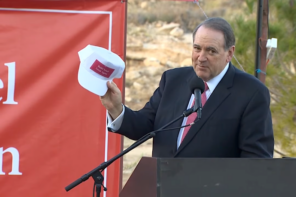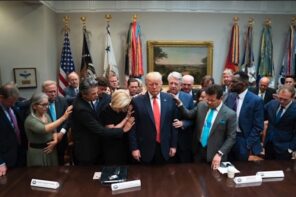Donald Trump continues to divide American evangelicals. Or at least that’s what the dwindling #NeverTrump crowd continues to insist, despite the evidence. This week, new polling found nearly 80% of white evangelicals say they will vote for Trump.
That’s good news for Trump, but a stinging rebuke to those who have made the case that “real evangelicals” should not support The Donald.
In last week’s Times op-ed, Peter Wehner, former speechwriter for George W. Bush and leading voice of the #NeverTrump crowd, dissected the “theology of Donald Trump” which he found to be “incompatible with Christianity.” “If you trace that worldview to its source,” Wehner wrote, “Christ would not be anywhere in the vicinity.”
Like other leaders of the #NeverTrump brigade, Wehner’s missive was inspired as much by the evangelicals who are supporting him as it was by the candidate himself. Responding to Trump’s meeting last month with more than 1,000 evangelical leaders in New York City, Wehner pointed to the “problematic” embrace of Trump by evangelical luminaries like Jerry Falwell, Jr., Franklin Graham, and James Dobson who recently vouched for Trump’s born-again status before saying he couldn’t confirm for sure Trump’s conversion.
More than just an embrace, Trump’s support from this motley crew of evangelical politicos helped clear the path for his unexpected march through the primaries to the Republican nomination. When, through this election cycle, Trump admitted he’d never asked God for forgiveness, when he fumbled at providing his favorite Bible verse, when he awkwardly described himself as a “Presbyterian and Protestant,” when he revealingly cited “Two Corinthians” – all of those telling missteps were brushed away by Trump’s doting evangelical backers; all of those miscues were rationalized by a power-hungry religio-political elite desperate to regain the White House.
Such is the stuff of politics, of course, but that it came from a group of conservative evangelical leaders who have spent the last forty years insisting on the unquestionable character and political orthodoxy of anyone who eyed the presidency has led many to conclude that the Religious Right’s efforts have always been more about political power than cultural reform.
Wehner’s piece acknowledged as much, arguing that evangelicals who supported Trump had been seduced by his own obsession with power – a word he used over and over in his New York City speech to them – and that they’re more concerned with restoring their own cultural and political power than with transforming the nation. Their willingness to support Trump, Wehner remarked, revealed that their “past moral proclamations were all for show and that power is the name of the game.”
Other #NeverTrump evangelicals have issued similar judgments of Trump’s evangelical supporters. And I have written and spoken admiringly of this #NeverTrump group. Anyone speaking out and acting against the duplicitous and demagogic Trump and his bid for the White House should be applauded.
But I’ve also suggested that the line separating anti-Trump evangelicals from Trump’s evangelical base is not as stark as some would suggest, and that the hands of the #NeverTrump folks aren’t as clean as they’d like to imagine when it comes to the forces that gave rise to Donald Trump.
This isn’t an argument about how strenuously they’ve resisted Trump, although this was how some interpreted my recent article. Russell Moore of the Southern Baptist Convention called my post “across the board, a shallow and historically clueless piece,” a curious criticism since I spent three-fourths of the article praising him and other #NeverTrump soldiers for their efforts.
Rather, my point there (developed more fully here) is that Trump’s rise fits squarely within the longer history of the Religious Right, a development constructed and cultivated by the very activists and organizations that now find themselves in opposition over the question of Trump. Trump, then, is not an aberration of the Religious Right, but rather one of its many fairly predictable outcomes.
Many observers have argued that the evangelical crackup over Trump represents the Religious Right’s ultimate unraveling, the endpoint of a forty-year history that peaked with the presidency of George W. Bush or perhaps even during the Reagan years, its first and last success all at once.
But this doomsday prediction of the Religious Right depends on a misreading of its past, seeing it as a unified and harmonious political force rather than as a religious movement that contained and endured internal divisions and disagreements even as it achieved political victories.
As I argue in my recent book We Gather Together, the history of the Religious Right is a story of the making and remaking of that shaky coalition of conservative evangelicals, Catholics, and Mormons.
Even among evangelicals, political partnership proved as challenging to come by as religious unity. But moderate evangelicals, fundamentalists, and Pentecostals alike understood that they had to set aside theological squabbles and denominational differences in order to present themselves as a sizeable and potent political force – a Moral Majority, one might say.
Mainstream evangelicals had long criticized these groups on religious terms, rebuking fundamentalists for their hostile separatism and blasting Pentecostals for their outlandish and possibly heretical worship styles. They reserved even harsher judgments for charismatics and the prosperity gospel movement.
Yet the rise of the Religious Right depended on drawing as wide a circle as possible in order to create a bigger movement with more political power. Mainstream evangelicals needed the fundamentalists, Pentecostals, charismatics, and prosperity gospel folks to come together for political ends. Moderate evangelicals hoped they could remain the leaders of the movement while the other groups merely provided the foot soldiers, but everyone thought they could issue the marching orders.
That wide coalition proved wildly successful at the ballot box, ushering Republicans into the White House and conservative politicians into Congress. It also brought the unruly and unsavory elements – from scandal-plagued televangelists to folks in the dominionism and Christian Reconstructionism crowd – into the fold, bulking up the Religious Right into the political force it became.
Respectable evangelicals tended to look the other way, pretending the wingnuts and extremists were radical outliers rather than key constituents of their coalition. But when these moderate evangelicals assumed influential positions in conservative media, Republican Party leadership, and even the White House, they did so in part because those same conservative Christians had helped buttress their power and influence.
Moderate evangelicals might now mock the rag-tag band of evangelicals who have gathered around Trump. And they might dismiss the story of the “false teacher” Paula White, a controversial prosperity gospel televangelist, leading Trump to Christ.
But they have also benefitted from all the times the Trumpvangelicals lined up behind more conventional causes. It was this wide coalition that helped elect Ronald Reagan and George W. Bush to the White House, and that rallied around the candidacies of John McCain and Mitt Romney.
It is this wide coalition that has backed anti-abortion measures, passed anti-gay legislation, and pushed the Republican Party further right.
And it is this wide coalition that made the Religious Right the most formidable force within the GOP and the powerbrokers of modern conservatism.
The #NeverTrump crowd has benefitted from all that. Now, faced with the rise of Donald Trump, they ought to also acknowledge that Trump too is reaping the benefits of a culture and movement they helped create, even if it now seems to have gotten out of their hands.




